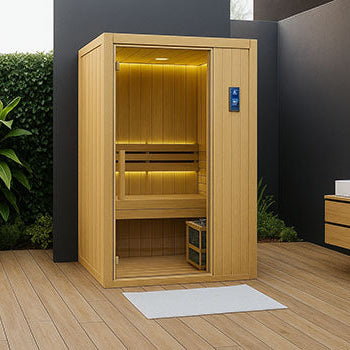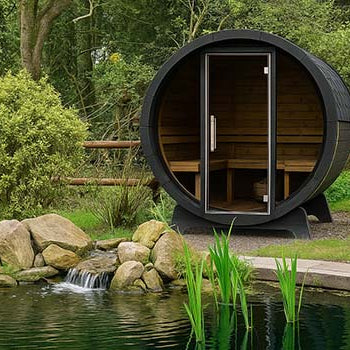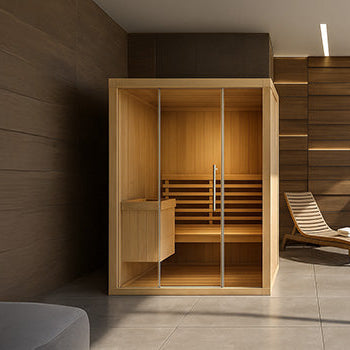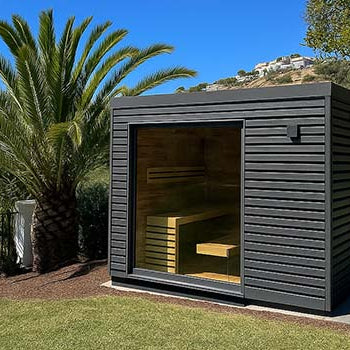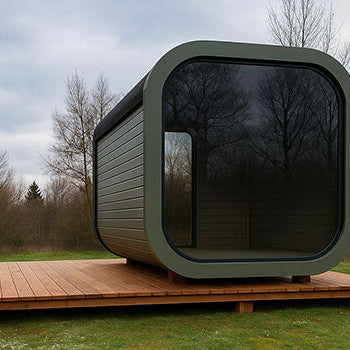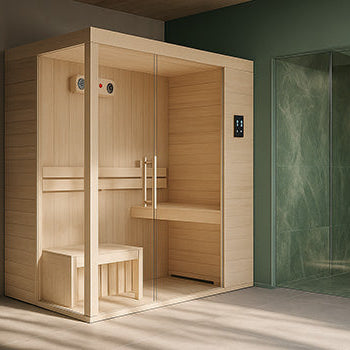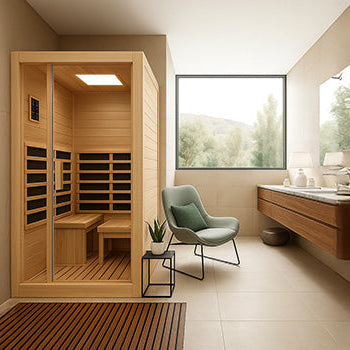Sweating it out in a steamy indoor cocoon or basking in your back garden heat pod—who wins the sauna showdown: traditional or infrared?
Short answer? It depends on how you like your heat served.
Traditional saunas give you the steam-room sweat lodge feel. Infrared’s more like a warm, comforting hug that works its way into your muscles.
Each has perks, but the better choice? That’s down to you—your body, your space, and how you want to feel. Let’s dive into the steamy details.

Traditional vs. Infrared Sauna: Which Comes Out on Top?
Think of it like choosing between espresso and herbal tea.
Both warm you up, both have loyal fans—but the experience? Different.
Traditional saunas bring the heat with all the drama—steam, sizzle, and high temps. Infrared saunas? They’re chill (well, still hot), but gentler, smoother, and more about the slow burn.
You’ll find both options in our curated collection of indoor saunas and outdoor saunas, with traditional and infrared models to suit your lifestyle.
Understanding the Fundamental Difference: How They Heat
Here’s the heat science in simple terms:
Traditional saunas warm the air around you, and that hot air warms you up.
Infrared saunas skip the air and go straight to your body using light waves.
One feels like walking into a hot room. The other? Like sunshine on your skin.
Both make you sweat, just in very different ways.
The Traditional Sauna Experience
Characteristics: High Air Temperature, Potential Steam (Löyly)
Traditional saunas crank up the temperature—usually somewhere between 70°C and 100°C. That’s hot enough to fog your glasses the moment you walk in.
They use hot rocks or heaters. Add a splash of water and boom—steam everywhere.
That’s what the Finns call löyly—a burst of hot steam that hits your skin and lungs in one go.
It’s intense. It’s old-school. It’s everything a sauna purist dreams of.
Looking for one? Explore our traditional indoor saunas or step outside with our range of traditional outdoor saunas.
Reported Benefits: Intense Sweating, Cardiovascular Effects, Relaxation
Fans of traditional saunas say it’s a full reset button for body and mind.
You’ll sweat a lot.
That’s good for flushing out toxins and giving your skin a deep cleanse.
Your heart rate goes up, almost like you’ve done light cardio.
It eases sore muscles and helps you switch off after a stressful day.
Bonus? It’s a social ritual in places like Finland. It’s not just wellness—it’s culture.
Potential Drawbacks: High Heat Intolerance, Longer Warm-Up, Higher Energy Use
Let’s be real—not everyone loves sauna-level heat.
If you’re sensitive to high temps or have certain health conditions, traditional might feel too much. It also takes longer to heat up—sometimes 40 minutes or more.
And if you’re energy-conscious, you’ll notice a bigger dent in your power bill.
Plus, installing one might not be easy unless you’ve got a dedicated room or an outdoor sauna cabin setup.
The Infrared Sauna Experience

Characteristics: Lower Air Temperature, Direct Body Heating
Infrared saunas are the modern twist. No steam, no fiery air—just gentle warmth that sneaks deep into your muscles.
They usually run between 40°C and 60°C. That might not sound hot, but don’t be fooled—you’ll still break a serious sweat.
They work by using infrared light to warm your body directly, not the air. Think radiant heat, like sitting near a campfire (minus the smoke).
Take a look at our infrared indoor sauna collection to explore compact options for your home spa setup.
Reported Benefits: Deeper Heat Penetration Claims, Pain Relief, Energy Efficiency, Faster Warm-Up
This is where infrared shines.
It heats faster, uses less energy, and is often easier to fit in your spare room or flat.
People with chronic pain or stiff joints often prefer infrared because it goes deeper into tissues and feels more manageable than traditional heat.
Less heat doesn’t mean less benefit—it just works differently.
And you can use it more frequently since it’s not as intense.
For garden-friendly models, our infrared outdoor saunas offer convenience with low energy use.
Potential Drawbacks: Different Sensation, EMF Concerns (Low-EMF Models Exist)
It’s not all sunshine and detox.
Some sauna lovers miss the intensity and ritual of traditional steam.
The dry, invisible heat can feel unfamiliar at first.
Then there’s the EMF worry—electromagnetic fields. But don’t stress too much.
Many newer infrared models are designed with low-EMF tech, so it’s worth doing your research and checking the specs before you buy.
Comparing Key Aspects Head-to-Head
Heat Intensity and User Comfort/Tolerance
Traditional is like a high-heat oven. Infrared is more like gentle radiant heat.
If you want to feel the burn (literally), traditional’s your jam.
If you prefer a slow and steady sweat without feeling overwhelmed, infrared may be a better fit.
Warm-Up Time and Energy Consumption
This one’s easy.
Infrared warms up in around 10 to 15 minutes. Traditional? It could take half an hour or more.
Infrared wins on speed and energy efficiency, hands down.
Installation, Space, and Cost Considerations
Got limited space or renting? Infrared is more compact and plug-and-play.
Traditional saunas need ventilation, bigger rooms, or outdoor space. Installation’s more involved—and often more expensive.
Infrared tends to be budget-friendly and easier to move.
Specific Health Claims and Supporting Evidence
Both sauna types support cardiovascular health, detoxification, and muscle recovery.
But when it comes to chronic pain or inflammation, infrared takes the lead in most clinical studies.
It’s all about how the heat reaches your body—deep penetration can mean more targeted benefits.
Making the Choice: Which Sauna Suits You Best?
Consider Your Heat Preference and Tolerance
Are you someone who loves that breath-stealing heat? Go traditional.
Prefer a milder, more manageable session? Infrared won’t push your limits.
There’s no wrong choice—just what feels right for you.
Align with Your Primary Health Goals
If your focus is on deep relaxation, mental calm, and intense sweating, traditional has you covered.
For pain relief, lower stress on the body, and frequent use—infrared is hard to beat.
It’s often the better choice for older adults or people with medical sensitivities.
Factor in Practical Considerations (Budget, Space, Energy)
Have a garden or dedicated space? Traditional saunas can give you that authentic outdoor sauna feel.
Short on space or on a budget? An infrared unit is easier to install, cheaper to run, and more compact.
Explore all our options in indoor saunas and outdoor saunas to match your space and style.
Conclusion: It's About Preference, Not Absolute Superiority

So… is traditional or infrared sauna better?
It’s not a battle—it’s a personal decision.
Think of them as two flavours of self-care. Traditional brings the ritual, the heritage, the sweat lodge vibes. Infrared brings innovation, ease, and comfort.
Choose based on your lifestyle, your body, and how you want to unwind.
Either way, you’re stepping into a healthier, calmer you. Just don’t forget to hydrate.
